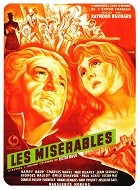Rendező:
Raymond BernardOperatőr:
Jules KrugerSzereplők:
Harry Baur, Charles Vanel, Jean Servais, Orane Demazis, Josseline Gaël, Max Dearly, Marguerite Moreno, Jean d'Yd, Pierre Larquey, Anthony Gildès, Florelle (több)Epizódok(3)
-
Une tempête sous un crâne (E01)
-
Les Thénardier (E02)
-
Liberté, liberté chérie (E03)
Tartalmak(1)
A francia irodalom egyik legnépszerűbb regényének 1934-ig ez már a tizenkilencedik megfilmesítése. Mind közül ez a legsikeresebb. A feldolgozás Jean Valjean sorsára koncentrálódik. A film alkotói erősen hangsúlyozzák a regény festőiségét. A fény-árnyék kontraszthatásokkal (a pompás, világos, rokokó terem után a szűk, sötét sikátor) képileg érvényesül a romantika kedvelt kifejezési eszköze. A forradalmi jelenetek időnként Delacroix-képeket idéznek. Honegger rendkívül szuggesztív zenéjének gyorsuló ritmusa érzékelteti a harc fokozódó feszültségét. (Örökmozgó)
(több)Recenziók (1)
A gritty retelling of a brutal novel. Europe's first sound adaptation is one of the great films of the 1930s, and on many levels it goes to the core. The runtime is of course generous, but numerous other transcriptions also struggled in one way or another in their attempt to shorten the 2000 pages. The performances match and often exceed the French standard of the time. The highlight is the story of poor Fantine in the very first part (the portrayal of this character is always a challenge, Hugo really gives us a lot of information about her, and here we have the opportunity to get to know Fantine before she meets her fate, which is why the sight of her death is so painful). The loathsome Thénardiers reign supreme in the second episode, their character traits easily overshadowed by the itch and disgust of their characters, settings and dwellings. And, of course, episode three shows the drama on and under the barricade. The time they spent on it was worth it.
()

